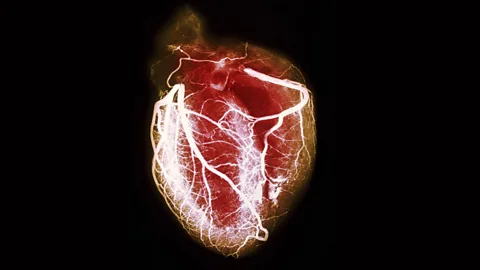Can you die of a broken heart?


Extreme emotion can be a killer, says Jason G Goldman. So why did it take doctors so long to see the evidence hiding in plain sight?
In 1986, a 44-year-old woman was admitted to Massachusetts General Hospital. She felt fine all day, but in the afternoon she developed extreme crushing pain in her chest, radiating through her left arm. It's a classic sign of a heart attack, but the puzzling thing was that she didn't suffer from coronary heart disesase. There was no life-threatening clot in the arteries surrounding the heart.
It looked, from the outside, like a heart attack, but it wasn't. Describing the unusual case in the New England Journal of Medicine, Thomas Ryan, and John Fallon suggest the apparent damage to the heart muscle was emotional rather than physiological. Earlier that day, she had been informed that her 17-year-old son had committed suicide.
Could the woman have suffered from a broken heart? The answer, it turned out, was already hiding in plain sight. The Massachusetts case was surprising to doctors – but it wasn’t news to everybody.
For many years, doctors scorned the idea of a relationship between psychology and physiology. In their book Zoobiquity, Kathryn Bowers and Barbara Natterson-Horowitz described this attitude: "Among many physicians, the idea that emotions could cause actual physical events within the architecture of the heart was viewed with nearly the same sideways glance as an interest in healing crystals or homeopathy. Real cardiologists concentrated on real problems you could see: arterial plaque, embolising blood clots, and rupturing aortas. Sensitivity was for psychiatrists."
Despite this, the evidence that extreme emotions can impact the heart goes back decades – only not among humans. It was wildlife biologists and veterinarians who first noticed that extreme emotions can wreak havoc on body physiology. By the mid-20th Century, they noticed that a curious thing happens when an animal experiences a sudden jolt of life-or-death fear. When it's caught by an advancing predator, adrenaline fills the bloodstream to such an extent that the blood almost becomes like a poison, damaging the animal's muscles, including the heart. It’s called “capture myopathy”.

By 1974, the effect was so well known to veterinarians that a letter in Nature proposing a possible way to avoid it didn't even bother explaining what it was in the first place. By then, researchers had realised that capturing animals for scientific or conservation purposes – such as for captive breeding, for mark-and-release studies, or for relocation – was often, ironically, fatal.
Indeed, by the time that physicians were puzzling over that strange, apparently emotion-driven heart-attack in Massachusetts, veterinarians had already recognised stress-related cardiomyopathy in a tremendous variety of non-human species: elk, pronghorn sheep, moose, deer, scimitar-horned oryx, antelope, muntjac, wisent, gazelle, dugongs, and wild turkeys. Since then, that list has expanded to include duikers, Arabian oryx, dolphins, whales, ducks, little bustards, partridges, river otters, cranes, bats, a variety of shorebirds, and a slow loris. Animals who are most prone to capture myopathy are small mammals, ungulates, birds, and anxious primates.
From around the mid-1990s, more case studies in humans, too, began to hint at physiological problems due to extreme psychological stress. In 1995, researchers Jeremy Kark, Silvie Goldman, and Leon Epstein found that Israelis were more likely to die as a result of heart-related problems on 18 January 1991 than on any day in the preceding and subsequent two months, as well as for the same period of time the previous year. That's because that's when the Persian Gulf War began, resulting in 18 missiles directed at Israel from Iraq. To be clear, the increase in mortality measured by this study was not due to injuries directly caused by the missile attacks; they were cardiovascular-related deaths that mostly occurred outside of hospital care.

"The perception of an imminent, life-threatening situation was widespread," the researchers wrote in the Journal of the American Medical Association. "To prepare for chemical attack, gas masks and automatic syringes containing atropine were distributed to the entire population. Every household prepared a sealed room. Civil defence instructions were issued in the media." The entire country was heavy with anxiety to begin with, and the life-or-death fear associated with missile strikes was too much for some to bear.
The following year, a different group of researchers took a look at sudden cardiac-related deaths in Los Angeles on 17 January 1994. That day was when a magnitude 6.8 earthquake – "one of the strongest earthquakes ever recorded in a major city in North America," the researchers noted – struck the region at 4:31am. In the New England Journal of Medicine, they reported a massive spike in cardiovascular-related deaths due to the stress of the early-morning jolt. As in the case of the Israeli missile attacks, that doesn't include traumatic injuries directly caused by the earthquake. These deaths are instead attributable to the extreme stress of being shaken awake by a violent earthquake. It should be noted, however, that many of those who died were not entirely healthy to begin with.
In the 1990s Japanese researchers coined the term “takotsubo cardiomyopathy” to describe a stress-induced apparent heart attack. It was so-named because the ballooning of the left ventricle characteristic of this sort of cardiomyopathy is reminiscent to a type of fishing pot, called takotsubo, which are used to trap octopuses.

But it wasn't until 2005 that enough studies had been described in the medical literature that human medicine began to fully take note. That year the concept of stress cardiomyopathy was firmly established within the medical literature, though many physicians still refer to is as takotsubo, or occasionally as "broken heart syndrome."
So while it isn’t necessarily sadness or rejection that can hurt us physiologically, there is now little doubt that the mind and our emotions can have a direct, measurable effect on our physical bodies, and when things take a turn for the worse, it can lead to catastrophe.
After consulting with veterinarians at the Los Angeles Zoo, it was Natterson-Horowitz, a UCLA cardiology professor, who put the heart-related aspects of capture myopathy with takotsubo cardiomyopathy side by side. In Zoobiquity, she and Bowers, a journalist, ask whether the two syndromes are really one and the same, afflicting humans and animals alike.
It’s just a shame that it took so long for doctors to accept what wildlife biologists and veterinarians had known for decades. If this episode teaches us anything, it’s that the traits we share with animals run far deeper than first appears. As this column has explored, the commonalities are myriad, whether it’s the ability to dance, to rule by democracy, or to lure the opposite sex with perfume. They’re written into the very fabric of our biology. Our species occupies but one tiny branch on the enormous tree of life; it would be a shame if our hubris prevented us from applying knowledge derived from decades of research on every other species on the planet to our own.
